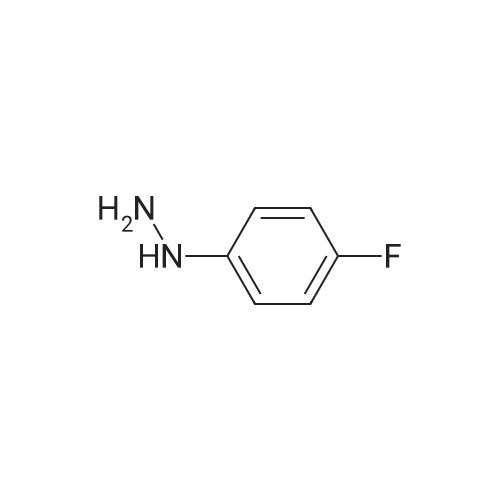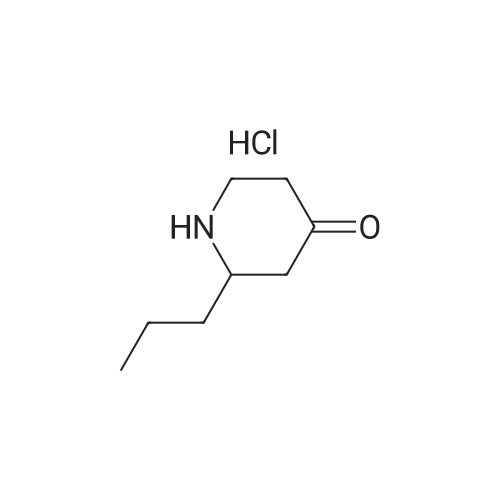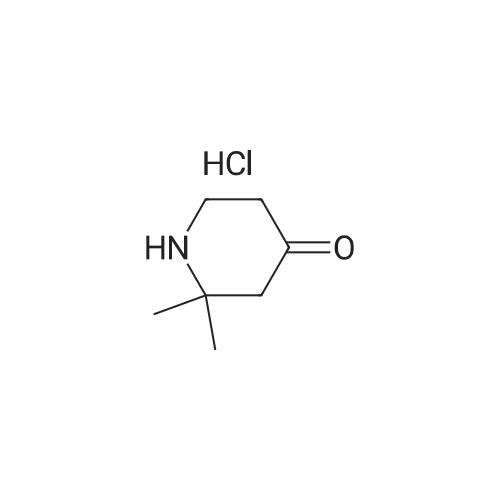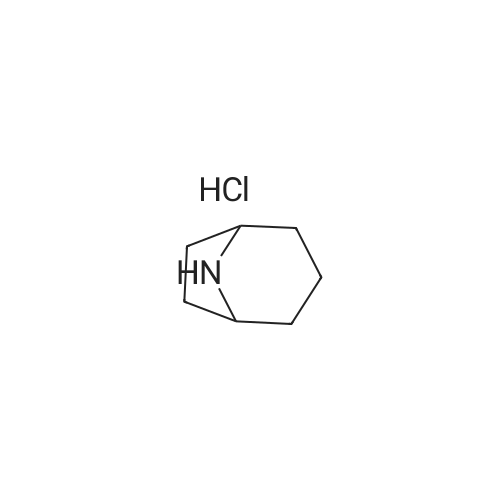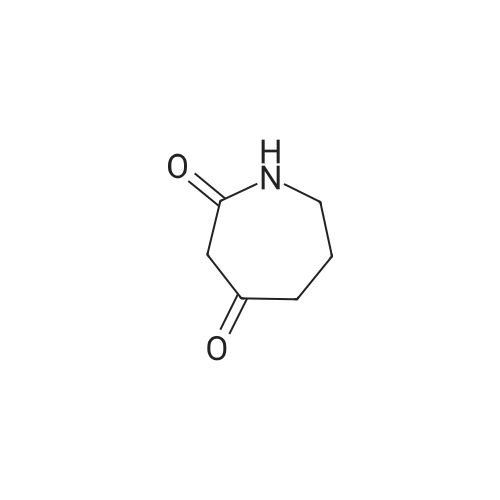| 43% |
|
Tropinone (10.0 g; 71.84 mmol) was dissolved in DCE (60 mL) and treated drop-wisewith 1-chloroethyl chloroformate ACE-C1 (14.5 mL; 19.11 g; 133.7 mmol). The reaction wasallowed to stir at room temperature overnight and was then diluted with Et20 (400 mL) andfiltered. The filtrate was concentrated under reduced pressure to provide the crude chloroethylcarbamate. This compound was taken in MeOH (200 mL) and stirred at room temperature for 1h, then concentrated under reduced pressure (at 55°C) to provide the crude des-methyltropinoneas the HC1 salt (tan solid, 11.4 g, 98percent yield). The crude material was recrystallized fromacetonitrile to furnish the pure product as a white crystalline solid (5 g, 43percent yield). *H NMR(400 MHz, DMSO-d6) 8 1.79 (dd, J= 15.0, 6.9 Hz, 2H), 2.09 (m, 2H), 2.40 (d, J= 16.7 Hz,2H), 3.02 (dd, J= 17.1, 4.3 Hz, 2H), 4.23 (s, 2H), 10.00 (br s, 2H)Des-methyl tropinone (5.10 g; 31.55 mmol) was dissolved in CH2CI2 (50 mL) and treated withbenzyl chloroformate (4.29 mL; 5.11 g; 29.98 mmol) DIPEA (16.48 mL; 12.23 g; 94.66 mmol)was added drop-wise (exothermic reaction). The resulting clear solution was allowed to stir atroom temperature for 30 min and was subsequently diluted with 100 mL CH2CI2. The organicphase was washed with 1 N HC1 (2 x 100 mL), dried on Na2SC>4 and concentrated to provide thecrude product (7.2 g, 88percent yield). *H NMR (400 MHz, CDC13) 8 1.71 (dd, J= 15.0, 7.2 Hz, 2H),2.12 (m, 2H), 2.38 (d, J= 15.9 Hz, 2H), 2.67 (m, 2H), 4.62 (s, 2H), 5.22 (s, 2H), 7.38 (m, 5H). |
|
|
Reference Example 1-1; 8-azabicvclor3.2Jloctan-3-one hydrochlorideIn 1,2-dichloroethane (100 mL) was dissolved tropinone (5.00 g). To the solution was added 1-chloroethylchloroformate (4,70 mL) at 00C, followed by stirring the mixture under heating to reflux for 6 hours. Methanol (100 mL) was added to the residue at room temperature, and the mixture was stirred under heating to reflux for 2 hours. The reaction solution was concentrated under reduced pressure, and the residue was then washed with diethyl ether to give the title compound (4.57 g) as a pale yellow solid, mass: 126(M+ 1 )+ . |
|
|
Tropinone (Fl) (10.0 g; 71.84 mml) was dissolved in DCE (60 mL) and treated drop- wise with 1-chloroethyl chloroformate ACE-Cl (14.5 mL; 19.11 g; 133.7 mmol). The reaction was allowed to stir at room temperature overnight and was then diluted with Et2O (400 mL) and filtered. The filtrate was concentrated under reduced pressure to provide the crude chloroethyl carbamate. This compound was taken in MeOH (200 mL) and stirred at room temperature for 1 hr, then concentrated under reduced pressure (at 55 0C) to provide the crude des- methyltropinone (F2) as the HCl salt, a tan solid. The crude material was recrystallized from acetonitrile to furnish the pure product as a white crystalline solid. 1H NMR (400 MHz, DMSO- d6) delta 1.79 (dd, J= 15.0, 6.9 Hz, 2H), 2.09 (m, 2H), 2.40 (d, J= 16.7 Hz, 2H), 3.02 (dd, J= 17.1, 4.3 Hz, 2H), 4.23 (s, 2H), 10.00 (br s, 2H) Des-methyl tropinone (F2) (5.10 g; 31.55 mmol) was dissolved in CH2Cl2 (50 mL) and treated with benzyl chloroformate (4.29 mL; 5.11 g; 29.98 mmol) DIPEA (16.48 mL; 12.23 g; 94.66 mmol) was added drop- wise (exothermic reaction). The resulting clear solution was allowed to stir at room temperature for 30 min and was subsequently diluted with 100 mL CH2Cl2. The organic phase was washed with 1 N HCl (2 x 100 mL), dried on Na2SO4 and concentrated to provide the crude product (F3). 1H NMR (400 MHz, CDCl3) delta 1.71 (dd, J= 15.0, 7.2 Hz, 2H), 2.12 (m, 2H), 2.38 (d, J= 15.9 Hz, 2H), 2.67 (m, 2H), 4.62 (s, 2H), 5.22 (s, 2H), 7.38 (m, 5H). |

 Chemistry
Chemistry
 Pharmaceutical Intermediates
Pharmaceutical Intermediates
 Inhibitors/Agonists
Inhibitors/Agonists
 Material Science
Material Science















 For Research Only
For Research Only
 120K+ Compounds
120K+ Compounds
 Competitive Price
Competitive Price
 1-2 Day Shipping
1-2 Day Shipping





